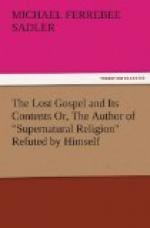This sending of our Lord on the part of His Father is one of the chief characteristics of the Fourth Gospel, and the reader, if he cannot examine this Gospel for himself, comparing it with the others, has only to turn to any concordance, Greek or English, to satisfy himself respecting this matter.
Jesus Christ is said to be “sent of God,” i.e. to be His [Greek: angelos], only once in St. Matthew’s Gospel (Matthew x. 40: “He that receiveth me receiveth Him that sent me"), only once in St. Mark (ix. 37), only twice in St. Luke (ix. 48; xx. 13), but in the Fourth Gospel He is said to be sent of God about forty times. [84:1] In one discourse alone, that in John vi., Jesus asserts no less than six times that He is sent of God, or that God sent Him; so that the dictum, “This representation of the Logos as angel is not only foreign to, but opposed to, the spirit of the Fourth Gospel,” is absolutely contrary to the truth.
SECTION XIV.
THE PRINCIPAL WITNESS ON THE DOCTRINE OF THE TRINITY.
The author of “Supernatural Religion” asserts:—
“The Fourth Gospel proclaims
the doctrine of an hypostatic Trinity
in a more advanced form than
any other writing of the New
Testament.” [85:1]
This is hardly true if we consider what is meant by the proclamation of the doctrine of a Trinity.
Such a doctrine can be set forth by inference, or it can be distinctly and broadly stated, as it is, for instance, in the First Article of the Church of England, or in the Creed of St. Athanasius.
The doctrine of the Trinity is set forth by implication in every place in Scripture where the attributes or works of God are ascribed to two other Persons besides The Father. But it is still more directly set forth in those places where the Three Persons are mentioned together as acting conjointly in some Divine Work, or receiving conjointly some divine honour. In this sense the most explicit declarations of the doctrine of the Trinity are the Baptismal formula at the end of St. Matthew’s Gospel, and the “grace,” as it is called, at the end of St. Paul’s Second Epistle to the Corinthians.
St. John, by asserting in different places the Godhead of the Word, and the Divine Works of the Holy Ghost, implicitly proves the doctrine of the Trinity, but, as far as I can remember, he but twice mentions the Three adorable Persons together: Once in the words, “I will pray the Father and He shall give you another Comforter.” And again, “But the Paraclete, which is the Holy Ghost, whom the Father shall send in My name, He shall teach you all things.”
Now, in respect of the explicit declaration of the doctrine of the Trinity, the statements of Justin are the necessary [86:1] developments not only of St. John’s statements, but of those of the rest of the New Testament writers.
I have given two passages in page 10.




